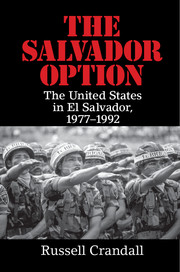Book contents
- Frontmatter
- Dedication
- Epigraph
- Contents
- List of Figures
- List of Organizations
- Acknowledgments
- 1 Introduction
- PART ONE EL SALVADOR IN THE COLD WAR
- PART TWO JIMMY CARTER
- PART THREE RONALD REAGAN
- 19 Reagan Arrives
- 20 Reagan and Salvador
- 21 El Mozote
- 22 Another Vietnam
- 23 Solidarity
- 24 Troop Cap and Certifying Human Rights
- 25 Reagan Gambles on Elections, 1982
- 26 The Shultz Doctrine
- 27 Human Rights
- 28 Henry Kissinger
- 29 Contras
- 30 “Elections Yes, Dialogue No,” 1984 Presidential Election
- 31 La Palma
- 32 Esquipulas
- 33 Counterinsurgency I
- 34 Counterinsurgency II
- 35 Zona Rosa
- 36 Air War
- 37 José Napoleón Duarte
- 38 Iran-Contra
- PART FOUR GEORGE H. W. BUSH
- PART FIVE POSTWAR
- Notes
- Bibliography
- Index
34 - Counterinsurgency II
from PART THREE - RONALD REAGAN
Published online by Cambridge University Press: 05 June 2016
- Frontmatter
- Dedication
- Epigraph
- Contents
- List of Figures
- List of Organizations
- Acknowledgments
- 1 Introduction
- PART ONE EL SALVADOR IN THE COLD WAR
- PART TWO JIMMY CARTER
- PART THREE RONALD REAGAN
- 19 Reagan Arrives
- 20 Reagan and Salvador
- 21 El Mozote
- 22 Another Vietnam
- 23 Solidarity
- 24 Troop Cap and Certifying Human Rights
- 25 Reagan Gambles on Elections, 1982
- 26 The Shultz Doctrine
- 27 Human Rights
- 28 Henry Kissinger
- 29 Contras
- 30 “Elections Yes, Dialogue No,” 1984 Presidential Election
- 31 La Palma
- 32 Esquipulas
- 33 Counterinsurgency I
- 34 Counterinsurgency II
- 35 Zona Rosa
- 36 Air War
- 37 José Napoleón Duarte
- 38 Iran-Contra
- PART FOUR GEORGE H. W. BUSH
- PART FIVE POSTWAR
- Notes
- Bibliography
- Index
Summary
We are involved in a war and somebody has to win.
– Sigfrido Ochoa, Salvadoran Colonel, 1987The guerrillas here have lost much popular support as a result of their three-year-old campaign of economic sabotage.
– Clifford Krauss, Wall Street Journal correspondent, 1984For three and a half years an army of 22,000 soldiers has been outfought by a force of about 7,000 guerrillas. The advisers’ mission is to transform that army into a winning team, and to do it quickly.
– Lydia Chavez, New York Times correspondent, July 1983In the previous chapter we provided an overview of the numerous challenges both U.S. officials and the FAES faced in the early 1980s in establishing a more formidable force to go against their FMLN adversaries. U.S. aid and equipment, an episodic commitment to decreasing human rights abuses, and a greater focus on counterinsurgency tactics and effective battlefield strategy combined to make the FAES a much more capable force. This chapter provides an overview of this critical turning point in El Salvador, when the FAES's new prowess propelled the FMLN to employ different, more aggressive tactics that in turn diminished the popular support they had counted on in the early 1980s.
“Señorita Casanova”
The Salvadoran government's fledgling effort to promote a more legitimate face, especially to the international community, took a significant turn for the better in 1984 when President Duarte appointed General Vides Casanova to replace José Guillermo García as defense minister. Vides was chosen since he appeared to be suitable to both ARENA's Roberto D'Aubuisson and key senior FAES officers. For frustrated U.S. Embassy officials, Vides's record as commander of the abusive National Guard suggested he would be a reactionary similar to his predecessor. In addition, Vides lacked experience commanding combat troops, which earned him the moniker “Señorita Casanova” among FAES officers.
Vides's exposure to Mao Zedong's military doctrine influenced his belief that the FAES needed to move toward a more concerted counterinsurgency strategy. Even more important, though, and a surprise to U.S. officials, he came to believe that ongoing reform of the military and security forces was crucial if the government was to continue receiving U.S. assistance, which was the only way that it could defeat the guerrillas. Along with new FAES Chief of Staff General Adolfo Blandón, Vides understood that “improving our image is worth millions of dollars of aid for the country.
- Type
- Chapter
- Information
- The Salvador OptionThe United States in El Salvador, 1977–1992, pp. 362 - 370Publisher: Cambridge University PressPrint publication year: 2016

